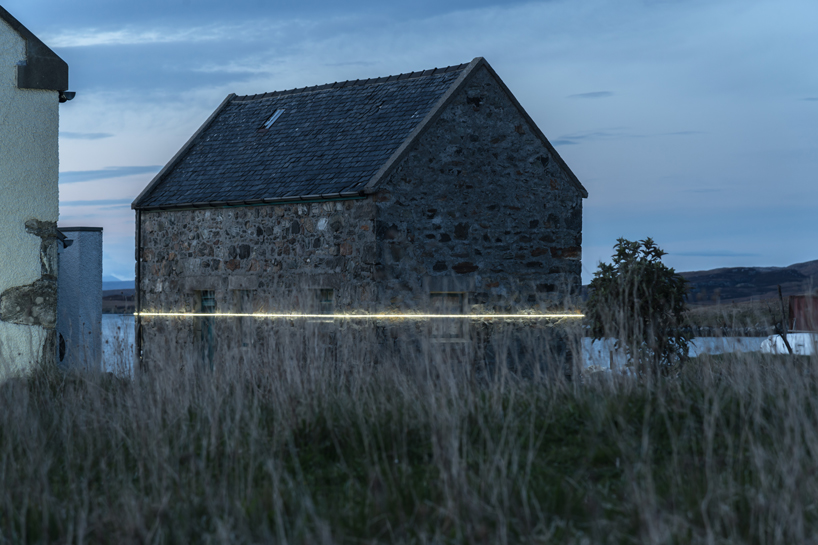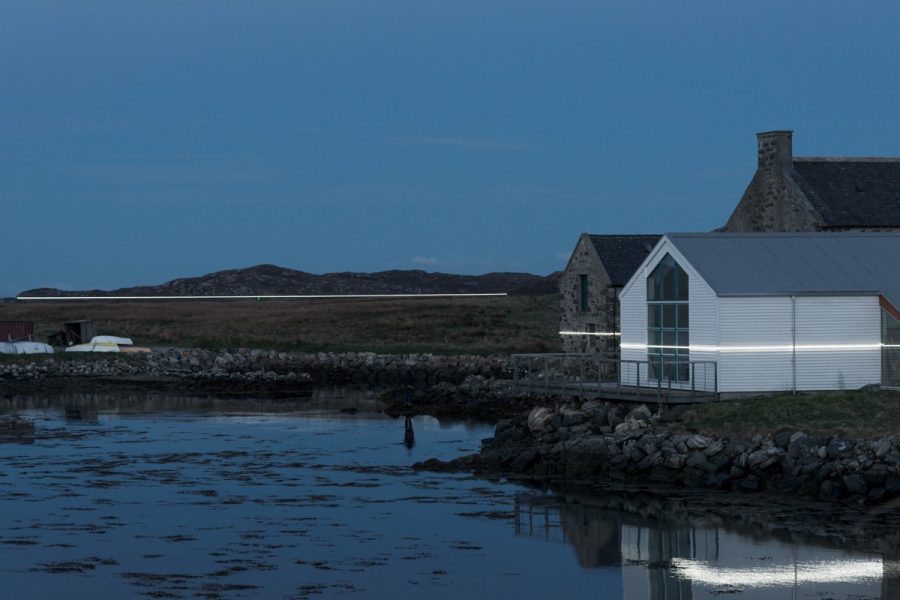What does it accomplish to talk about climate change? Even those who talk about climate change professionally might find it hard to say. If you really want to make a point about rising sea levels — not to mention all the other changes predicted to afflict a warming Earth — you might do better to show, not tell. That reasoning seems to have motivated art projects like the giant hands reaching out from the waters of Venice previously featured here on Open Culture, and it looks even clearer in the more recent case of Lines (57° 59 ́N, 7° 16 ́W), an installation now on display on a Scottish island.

All images courtesy of Timo Aho and Pekka Niittyvirta
“At high tide, three synchronized lines of light activate in the Outer Hebrides off the west coast of Scotland,” writes Designboom’s Zach Andrews, and in the dark, “wrap around two structures and along the base of a mountain landscape.
Everything below these lines of light will one day be underwater.” Created by Finnish artists Pekka Niittyvirta and Timo Aho for Taigh Chearsabhagh Museum & Arts Centre, Lines (57° 59 ́N, 7° 16 ́W) offers a stark reminder of the future humanity faces if climate change goes on as projected.

But why put up an installation of such apparent urgency in such a thinly populated, out-of-the-way place? “Low lying archipelagos like this one are especially vulnerable to the catastrophic effects of climate change,” Andrews writes, adding that the Taigh Chearsabhagh Museum & Arts Centre itself “cannot even afford to develop on its existing site anymore due to the predicted rise of storm surge sea.” But though the effects of rising sea levels may be felt first on islands like these, few predictions have those effects stopping there; worst-case scenarios won’t spare our major metropolises, and certainly not the coastal ones.

You can get a sense of what Lines (57° 59 ́N, 7° 16 ́W) looks like in action from the photographs on Niittyvirta’s site a well as the time-lapse video at the top, which shows the lines of light activating when their sensors detect high tide, then only those lines of light remaining by the time the sun has gone completely down. To experience the full impact of the installation, however, requires seeing it in person in the context for which it was created. So if you’ve been putting off that trip to the Outer Hebrides, now might be the time to finally take it — not just because of Niittyvirta and Aho’s work, but because in a few years, it may not be quite the same place.
Related Content:
A Song of Our Warming Planet: Cellist Turns 130 Years of Climate Change Data into Music
A Century of Global Warming Visualized in a 35 Second Video
Based in Seoul, Colin Marshall writes and broadcasts on cities, language, and culture. His projects include the book The Stateless City: a Walk through 21st-Century Los Angeles and the video series The City in Cinema. Follow him on Twitter at @colinmarshall or on Facebook.


This is a beautiful and elegant expression of the neurotic fear instilled by politically minded and funded science. The recognition that we can all imagine, through a sort of gestalt cognition, the nightmare that we are being forced to believe is possible “in a few years” adds a layer of genius that only the most sophisticated exhibitionist could conjure.
In the meantime sea levels refuse to rise… Not an inch since the climate change hysteria was launched, perhaps 2 decades ago now.
@ Joseph
At least 3 inches.
“More precise data gathered from satellite radar measurements reveal an accelerating rise of 7.5 cm (3.0 in) from 1993 to 2017, which is a trend of roughly 30 cm (12 in) per century.”
( https://en.wikipedia.org/wiki/Sea_level_rise )
Al Gore said the New York City would already be underwater by now.
He then made a fortune selling his TV station to an Middle Eastern oil state.
He continues to earn large amounts of money giving lectures on his not so vast grasp of science.
Say it often enough and loudly enough and people will be coerced to believe it. If they don’t, just ridicule them. Straight out of Alinsky.
Thanks Dan,
That still only adds up to perhaps 14 inches in a century… A passing motorboat causes higher ripples than that. There might be a steady rise in sea levels, part of a natural cycle. The doomsayers claim that the rise will accelerate at some certain mythical date, a date always postponed, based on no facts… As for the natural cycle, perhaps not reassuring or even frightening a bit, but one could walk from England to France or Russia to Alaska before the last Ice Age ended and the sea levels rose.
Joseph, it’s worth noting that the rate of increase is accelerating. Let me refer you again to NASA
https://climate.nasa.gov/news/2680/new-study-finds-sea-level-rise-accelerating/
And you’re generally trivializing what these increases mean.
I’d recommend giving this other government web page a read: https://www.climate.gov/news-features/understanding-climate/climate-change-global-sea-level
No matter that climate goes through cycles. It has been so for eons and will continue on for eons. We have minimal effect. To think more is pure hubris.
Happy Earth Day — Celebrating 50 years of the earth ending in 10 years.
Dave is basically right. The climate has always changed. The notion that human beings are responsible for any of these changes is very far from clear. Here is a video from Patrick Moore, formerly of Greenpeace, explaining the difficulties with causation in this area: https://youtu.be/RkdbSxyXftc